- Home
- Stephen Baxter
Titan Page 20
Titan Read online
Page 20
“I know, I know. But all we need is one of these flights to fail, just one, and we won’t have the lift capacity we need. And I might be the person who has to deliver one of those flights. And carry the can when it blows apart.”
They were taken to the floor of the facility now, and walked underneath the still-graceful chin of the orbiter. The smooth, shaped surface of Atlantis’s belly loomed over Libet, dark and sheer, and she could see the complex mottling of the tiles and blankets of the thermal protection system.
Those tiles, all thirty thousand of them, had absorbed thousands of man-hours of development and testing. And then every one of them, shaped for a particular location on the orbiter’s complex surface, had had to be fitted individually, by hand. It was a monumental, medieval labor.
But now, teams of technicians were again working on the belly of Atlantis. They were on movable platforms, and they reached up and scoured and painted and dug; each of them looked like Michelangelo working in the Sistine, she thought vaguely. But what they were doing was far from creative: they were detaching those painfully-applied tiles, one by one. All in the interests of saving weight; on her last mission, Atlantis didn’t even need her thermal protection any more.
Discarded tiles lay around on the floor of the facility, some of them streaked and discolored by Atlantis’s final atmospheric entry.
The tiles on the underside of the craft were coated with a black, reflective glass patina. The shaped surface returned complex highlights from the bright working lights of the Boeing facility. The effect of the ceiling of tiles above her, with its subtle contours, was quite beautiful, she thought; it was like the roof of some modern church.
Libet shook her head. “My God. It’s an act of vandalism. We’re taking fully operational spacecraft, all this mature technology—national treasures, for God’s sake—and stripping them down to serve as garbage scows.”
Fahy smiled at Libet. “We’ve been through this. The only alternative to Shuttle-C is to turn the damn things into café bars, like the Russians did to Buran. You can’t tell me you’d prefer that.”
“Hell,” Libet grumbled. “It’s just—”
“What?”
“It’s just, being an astronaut is all I ever wanted to do. Flying in space, traveling to new worlds. To Nimbar, or Vulcan, or Bajor, or through that damn wormhole… But here in the real universe I got nowhere to go, except Titan, and that’s a lethal ice-ball, and we’re having to burn up everything to get there. I keep on feeling I was born in the wrong universe.”
Fahy laughed. “But you’re lucky, Siobhan. At least you are heading out. And there ain’t nobody who’s going to follow you, not in my lifetime, or a long time afterward.”
The party moved on.
They were taken to a balcony overlooking another area of the assembly facility floor. Here—Libet hadn’t been expecting this—Boeing employees, maybe a couple of hundred of them, had gathered. They were standing in their white coats and plastic overshoes, looking up at their visitors.
Jardine started giving them a pep talk. “… We’re scheduled to begin power-on systems testing in a couple more months,” he said. He beamed out at his workers from under the brim of his white hat. “And that puts us significantly under budget and only a month behind schedule, which we will recover. I attribute that to a mature Shuttle program expertise, careful planning and foresight by Boeing and NASA, and, most importantly, the hard work of thousands of people. I mean you people, right here, and I have never worked with a better bunch of quality workers in all my years in this business…”
He got a ripple of applause for that.
Then, to Libet’s horror, Jardine said something about how they were honored to have with them one of the people who this program was all about, the latest chapter in Boeing’s long and proud space tradition… And Libet found herself being pushed forward, until she reached a discreet black microphone on a stand in front of her.
She looked back at Fahy, appealing. Fahy shrugged, apologetically, and held her palms out flat. Take it easy.
Libet looked out over the little pool of faces. Like so many in the space industry, the workers here weren’t young, on average; there were plenty of gray hairs pushing out from under those gleaming white hats. This last effort probably meant the end of their careers, she realized. And they were all looking up at her from the assembly facility floor.
Their faces were—empty Shining.
I fascinate them, she realized.
Holy shit, she thought. Astronauts nowadays weren’t prepared for this stuff. All her PR training had been about playing down the wonder stuff. Being an astronaut was just a job, right?
But this was different. It was as if she was John Glenn, ready to go off to the high frontier. Maybe to die. Evidently Paula had been right in her hunch that this Titan mission would, one last time, grab the imagination of the people.
But, Libet thought, what in hell do I say?
Then the question came, called up from the floor. What’s it like to fly in space?
There was a ripple of nervous laughter.
She held the microphone and tried to reply. “… It’s like nothing you can imagine. The photos, the IMAX films, the VRs, nothing captures it. I feel like a child. I feel like I’ve been to a secret place. And now you guys are sending me back…”
They were watching her, expectant, silent.
She remembered stories of early astronauts as they’d toured similar facilities, fifty years ago. And she remembered what Grissom, or Cooper or Glenn or Shepard, had said in one such place, at Convair or McDonnell Douglas or Boeing.
She leaned forward to the microphone, and said: “Do good work.”
There was a long silence.
Then applause started rippling around the assembly area floor, rigorous, laced by a couple of whistles.
Billy Ray Jardine’s heavy hand clapped her back.
Deeply embarrassed, she retreated.
Barbara Fahy approached her, grinning. “Welcome to the space program,” she said.
Marcus White kept track of the modifications Don Baylor and his team tried, to lick the instability problem in that balky old F-1 engine.
They put baffles into the combustion chamber, copper plates that extended down from the injector plate, that would interrupt those rebounding instability waves. But the baffles just bent over like blades of grass in a breeze. So they put in massive dams, slabs of two-inch-thick copper, cooled by a kerosene flow. That helped some, but the worst instabilities still overcame the damping effect of the baffles.
Eventually, sparked off by obscure test results from the old documentation, Baylor tried another approach. He changed the impingement angle of the propellant streams coming through the holes in the injector plate. That way the fans of lox and kerosene were formed further down inside the chamber. There was a cost to this, because the engine efficiency was reduced; the further down the streams met, the less completely they burned before being expelled from the chamber. But with that new angle of impingement, Baylor and his team managed, at last, to reduce substantially the occurrence of instability.
So they went to work on that basic design, fine-tuning it, shaving thin slices off the engine orifice, until at last they weren’t getting the instability at all.
“Fucking A,” White told him. “You ought to take your guys out and get oiled up and—”
“Marcus, you don’t understand. For us there’s no splashdown party. We never know for sure that we’ve won. Look, it’s not as if we wrote out equations and ran computer models to show that we’ve removed the instability. All we’ve done is modify the design until it went away. And we don’t for sure know how. That instability is lurking in there, you can be sure about it. All I can do now is hope that it doesn’t find some way to strike before we finish firing off those four birds.”
“You’re a pessimist, Baylor,” White snapped. “Look, in the Apollo program they fired thirteen flights, sixty-five F-1 engines, and never a failure. So ther
e, you got yourself a hundred percent reliable engine.”
Baylor had laughed. “The logic doesn’t work like that, Marcus. History is a poor indicator of reliability. Read Feynman.”
“Who?”
“Never mind. you know, we ransacked the documentation they left behind from the 1960s but there’s no real clue about how they mastered this in the end. There’s a rumor they just got a bunch of craftsmen at Canoga Park to drill holes at random in the damn plate, until they found something that worked. Maybe it wasn’t just a sea story…”
Baylor just wouldn’t lighten up, to the end.
Anyhow, the F-1 refurbishment was done, for better or worse. And now it was time to launch.
Marcus White packed his bags for the Cape.
It was going to be the first Saturn V launch since 1973. And Barbara Fahy was going to get to direct it.
She followed the components of booster AS-514 through their refurbishment and assembly. The third stage, the S-IVB, was delivered to KSC from McDonnell by a “Super Guppy,” a fat transport aircraft, one of the few of its type still flying. The two other stages arrived by barge, the S-II second stage from Boeing’s facility at Seal Beach in California, and the S-IC from NASA’s Michoud facility’ in Louisiana.
Fahy watched the S-IC arrive on a barge called Neptune, at the refurbished Saturn unloading facilities on the Banana River. The stage, a prone cylinder a hundred and forty feet long, was wrapped up in plastic like some bizarre piece of modern art. Teams of technicians descended on the stage, checking to make sure that the various wrappings and protective devices had not been damaged during the long transit. The techs were youngsters supervised by a handful of grizzled old heads who remembered this stuff from the last time they’d done it, in the 1970s.
The S-IC alone was gargantuan. Most of its cylindrical length was taken up by its fuel and oxidant tanks. The five F-1 s, gleaming as it new, were fixed to a massive thrust structure, twenty-four tons of it. And beyond them the stage’s fins flared above the technicians, spanning sixty feet.
Actually this S-IC had benefited from considerable rebuilding; much of the intertank, engine fairings and the fins had been replaced with new composite materials and lightweight aluminum-lithium alloys. The other two stages had been similarly reworked.
The S-IC was taken to the Low Bay of the Vehicle Assembly Building, where it was checked over prone for the final time. Then it was taken to the High Bay, where lines were attached from the crane overhead, and the S-IC lifted upright and settled gently into place aboard the mobile launch platform.
The second stage, the S-II—itself all of ninety feet long—was hauled three hundred feet into the air and set delicately atop the S-IC. It was like watching a skyscraper being assembled, in giant prefabricated chunks.
Back in the 1960s, the guys who ran the VAB cranes would boast that they could rest the hooks of their gigantic machines so delicately that they could touch an egg without breaking it. But those days were gone; now the cranes were fully automated and controlled to within fractions of an inch by sonar and infrared systems. The job of humans now was to watch the machines perform more precisely and reliably than they ever could.
When the two stages were aligned, technicians moved in to join them. Three big twelve-inch pins were set at equal spacings around the cylindrical geometry of the join, and over two hundred one-and-a-half-inch fasteners were fixed at six-inch intervals. It took three days to stitch the stages together. The guys in the ’60s could do it in eight hours, the old timers said.
Next the S-IVB was lifted over the second stage and joined up similarly. And finally the payload—a cylindrical tank, swathed in insulation, that would hold a hundred and eighty thousand pounds of propellant for the Titan mission—was mated to the S-IVB.
Walking around the base of the assembled Saturn, Fahy peered at its upper stages, so remote they seemed lost in the misty air above. AS-514 was the operational Saturn which had for three decades sat on the lawn outside JSC in Houston, after its requirement as a lunar mission launcher was deleted. There was hope that this bird, which had at least been of operational standard back in the 1970s, would give them all fewer problems than the two upgraded test articles they would have to fly later.
Maybe. Fahy was expecting trouble.
This would be her first flight since Columbia. She wasn’t the lead director for the mission, but she had been entrusted with the ascent phase, the most dangerous and complex phase of any flight.
She’d gone through the events of that final, fatal landing so many times that she could recite the mission logs. STS-143 had grown in her mind, until it was as if the particular circumstances of that mission were the only way any Shuttle mission could ever have been flown, as it the whole thing had been fixed and unalterable, its deadly script written into history even before Columbia had lifted off the pad.
But then, along had come Paula Benacerraf, with her bizarre and wonderful visions of a mission to Titan…
When she’d been offered the chance to work on this flight, Fahy had jumped at it.
It was just what she needed, she figured. Maybe she could prove to herself that she could act, make decisions, influence the unfolding of events—prove that she wasn’t just a victim of some blind predetermined fate.
Then, perhaps, she could get on with the rest of her life.
And anyway, she reflected more cynically, a good performance here could be a way of restarting her damaged career, within the shrunken, emasculated NASA that was going to emerge from this mess.
… But the Saturn V overwhelmed personal considerations like that. The Saturn was so damned big.
Fahy had grown up with Shuttle. But the Saturn V was just about twice as tall as the Shuttle stack. And those balky F-1s, which had given the guys at Marshall so much trouble, could each develop the power of four Shuttle main engines.
The Saturn, assembled, was like some dinosaur, returned to stalk the Earth. She began to feel intimidated by the booster, as if it would be impossible for her, a mere human, to control it.
Testing and check-out went on. There were hundreds of tests of the completed booster’s electrical networks, fire detection, telemetry, tracking, gyroscopes, computers, pumps, transducers, valves, cables, plugs, hydraulics. That took four months alone. Then there was a further set of integrated tests of the booster with its payload and the ground support equipment. There were tests of contingency procedures in case of a malfunction at launch—for instance, if an umbilical swing arm failed to disconnect. There were integration tests to check the hundreds of wire and cable pathways connecting the stages and payload, tests of each of the hundreds of pins in the umbilicals’ electrical interfaces with the vehicle.
Slowly, painfully, Fahy could see progress being made; verification seals and sign-offs started to accumulate, immersing the vehicle in a kind of invisible scaffolding of paperwork.
And, eventually, the booster was rolled out to Launch Complex 39-A.
At the pad, the technicians began more layers of tests: a plugs-in test of all the system’s components, a flight readiness test, a full simulated launch and mission, and a Countdown Demonstration Test, a crucial checkout for the bird’s preparation for launch. In the days of Apollo, CDTs would take maybe four days—sixty hours of testing, and thirty-six hours of planned holds. Fahy hoped they’d get away with not much more than that—say, six or seven days.
The test took seventeen days.
None of the equipment—either the stuff modified from Shuttle operations, or old Saturn gear dug out of storage and refurbished—seemed to work the way it was supposed to. The regulators which controlled the flow of propellants into the Saturn’s stages kept throwing up problems; they simply weren’t designed for such heavy flows. The Saturn V’s own Instrument Unit—the brains of the bird, stuffed full of antique 1960s electronics which nobody dared tear out and replace—couldn’t keep the electronics boxes as cool as they needed to be. Cable connections on the S-II shorted out, in the humidity and
moisture around the pad; when they were checked they were proved to be corroded, damage missed by the refurbishment teams.
Everything took much longer than planned.
Even when propellant loading began, the process took hours, as more than a hundred truck-loads of kerosene, lox and liquid hydrogen were pumped into the Saturn’s three stages. And every time the countdown test hit a problem and had to be stopped, the propellants guys had to stay in the Firing Room and detank, a process even more tedious than tanking.
The various teams became exhausted as the test dragged on. Eventually the managers ordered a two-day break.
But still the test limped on, eroding through its checklist. The team got through to the twenty-six-minute mark, the completion of the test of power transfer. Then they began the process of prechilling the thrust chambers in the second and third stages.
Then, amazingly, they reached the start of the automatic count sequence, at minus three minutes and seven seconds. Fahy watched as the final automatic procedures cycled through, controlled by 1960s software re-engineered to run on computer hardware vintage 2007…
The clock stopped, as planned, at minus fourteen seconds.
Now, forty years late, AS-514 was at last a fueled, checked-out, fully operational vehicle, and the team had done everything it would do on the launch day except light the igniters.
There was a burst of ragged applause.
Good God almighty, she thought. We’re really going to do this.
On the last day, Fahy walked among the crowds at the KSC visitors’ center. She heard grandparents pointing out the needle-slim Saturn on its pad. They tried to tell their grandchildren about how they’d watched the launch of Apollo 11—or 12, or 13, or 14—when they were little kids themselves.
The kids looked on, bemused, asking questions—they’re really going to throw all of that away? how much junk did they leave on the Moon? is the Moon really as messed up as they say?

 The Martian in the Wood
The Martian in the Wood THE H-BOMB GIRL
THE H-BOMB GIRL World Engine
World Engine Titan n-2
Titan n-2 Newton's Aliens: Tales From the Anti-Ice Universe
Newton's Aliens: Tales From the Anti-Ice Universe Exultant
Exultant Manifold: Origin
Manifold: Origin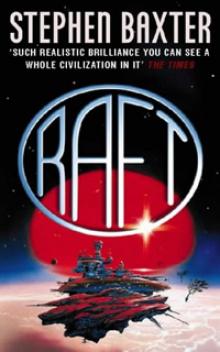 Raft xs-1
Raft xs-1 Bronze Summer n-2
Bronze Summer n-2 Transcendent
Transcendent Stone Spring
Stone Spring Coalescent
Coalescent The Medusa Chronicles
The Medusa Chronicles Origin m-3
Origin m-3 Silverhair tm-1
Silverhair tm-1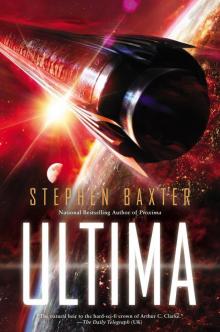 Ultima
Ultima Voyage n-1
Voyage n-1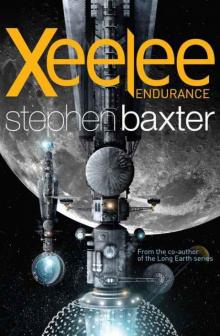 Xeelee: Endurance
Xeelee: Endurance Space m-2
Space m-2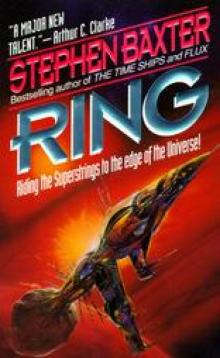 Ring xs-4
Ring xs-4 Raft
Raft Xeelee: Vengeance
Xeelee: Vengeance Iron Winter n-3
Iron Winter n-3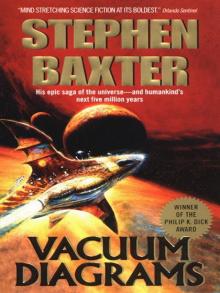 Vacuum Diagrams
Vacuum Diagrams Longtusk tm-2
Longtusk tm-2 Proxima
Proxima Evolution
Evolution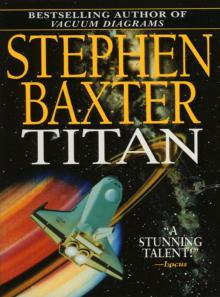 Titan
Titan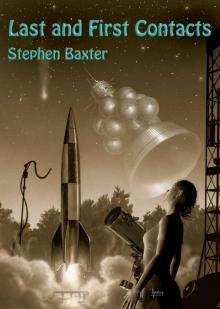 Last and First Contacts (Imaginings)
Last and First Contacts (Imaginings) Emperor
Emperor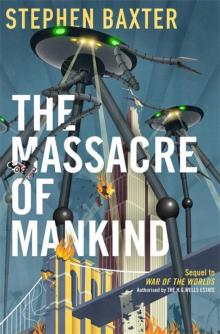 The Massacre of Mankind
The Massacre of Mankind Starfall
Starfall Doctor Who - The Wheel of Ice
Doctor Who - The Wheel of Ice Longtusk
Longtusk Silverhair
Silverhair Conqueror tt-2
Conqueror tt-2 Flood
Flood Flood f-1
Flood f-1 Emperor tt-1
Emperor tt-1 Moonseed
Moonseed Conqueror
Conqueror Timelike Infinity xs-2
Timelike Infinity xs-2 The Ghost Pit
The Ghost Pit Xeelee: An Omnibus: Raft, Timelike Infinity, Flux, Ring
Xeelee: An Omnibus: Raft, Timelike Infinity, Flux, Ring Weaver tt-4
Weaver tt-4 Landfall: Tales From the Flood/Ark Universe
Landfall: Tales From the Flood/Ark Universe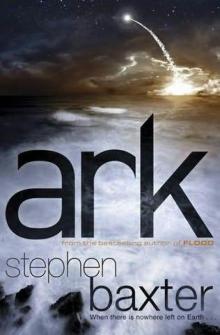 Ark
Ark Emperor: Time’s Tapestry Book One
Emperor: Time’s Tapestry Book One Space
Space Icebones
Icebones Manifold: Space
Manifold: Space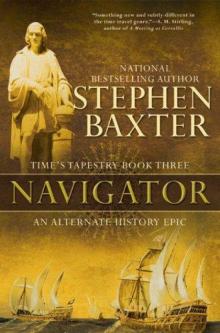 Navigator
Navigator Obelisk
Obelisk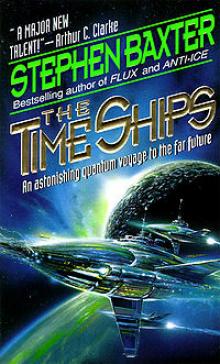 The Time Ships
The Time Ships Bronze Summer
Bronze Summer Resplendent
Resplendent Moonseed n-3
Moonseed n-3 Flux xs-3
Flux xs-3 Transcendent dc-3
Transcendent dc-3 Icebones tm-3
Icebones tm-3 Phase Space
Phase Space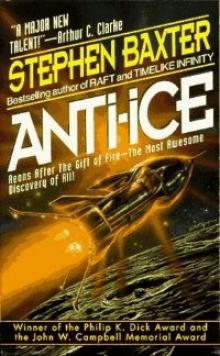 Anti-Ice
Anti-Ice Weaver
Weaver Voyage
Voyage Time m-1
Time m-1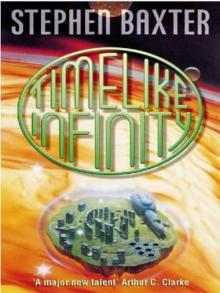 Timelike Infinity
Timelike Infinity Exultant dc-2
Exultant dc-2 Coalescent dc-1
Coalescent dc-1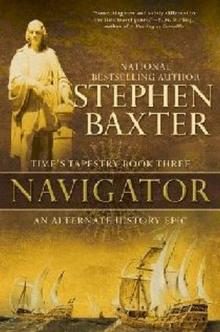 Navigator tt-3
Navigator tt-3